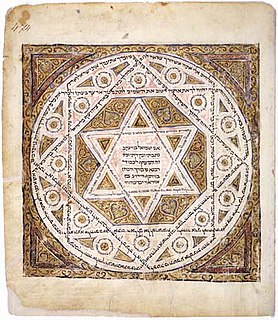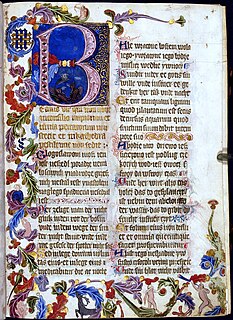
The Bible is a collection of religious texts or scriptures sacred to Christians, Jews, Samaritans, Rastafari and others. It appears in the form of an anthology, a compilation of texts of a variety of forms that are all linked by the belief that they are collectively revelations of God. These texts include theologically-focused historical accounts, hymns, prayers, proverbs, parables, didactic letters, erotica, poetry, and prophecies. Believers also generally consider the Bible to be a product of divine inspiration.

The New International Version (NIV) is an English translation of the Bible first published in 1978 by Biblica. The NIV was published to meet the need for a modern translation done by Bible scholars using the earliest, highest quality manuscripts available. Of equal importance was that the Bible be expressed in broadly understood modern English.

The Vulgate is a late-4th-century Latin translation of the Bible. It was to become the Catholic Church's officially promulgated Latin version of the Bible during the 16th century and is still used in the Latin Church alongside the Hebrew and Greek sources.

The New American Standard Bible (NASB) is an English translation of the Bible by the Lockman Foundation. The New Testament was first published in 1963, and the complete Bible in 1971. The most recent edition of the NASB text was published in 2020.

The Leningrad Codex is the oldest complete manuscript of the Hebrew Bible in Hebrew, using the Masoretic Text and Tiberian vocalization. It is dated 1008 CE according to its colophon. The Aleppo Codex, against which the Leningrad Codex was corrected, is several decades older, but parts of it have been missing since 1947, making the Leningrad Codex the oldest complete codex of the Tiberian mesorah that has survived intact to this day.

The Reina–Valera is a Spanish translation of the Bible originally published in 1602 until United Bible Societies in 1909 revised the earlier translation produced in 1569 by Casiodoro de Reina. This translation was known as the "Biblia del Oso" because the illustration on the title page showed a bear trying to reach a container of honeycombs hanging from a tree. Since that date, it has undergone various revisions notably those of 1602, 1862, 1909, 1960, 1977, 1995, and more recently in 2011.
The Christian Community Bible is a translation of the Christian Bible in the English language originally produced in the Philippines.

The Biblia Hebraica Stuttgartensia, abbreviated as BHS or rarely BH4, is an edition of the Masoretic Text of the Hebrew Bible as preserved in the Leningrad Codex, and supplemented by masoretic and text-critical notes. It is the fourth edition in the Biblia Hebraica series started by Rudolf Kittel and is published by the Deutsche Bibelgesellschaft (German Bible Society) in Stuttgart.

The Biblia pauperum was a tradition of picture Bibles beginning probably with Ansgar, and a common printed block-book in the later Middle Ages to visualize the typological correspondences between the Old and New Testaments. Unlike a simple "illustrated Bible", where the pictures are subordinated to the text, these Bibles placed the illustration in the centre, with only a brief text or sometimes no text at all. Words spoken by the figures in the miniatures could be written on scrolls coming out of their mouths. To this extent one might see parallels with modern cartoon strips.
João Ferreira Annes d'Almeida (1628–1691) was a Portuguese Protestant pastor; the eponymous Bible translation he began also goes by his name.
Several Spanish translations of the Bible have been made since approximately 700 years ago.
The Theological Markup Language (ThML) is a "royalty-free" XML-based format created in 1998 by the Christian Classics Ethereal Library (CCEL) to create electronic theological texts. Other formats such as STEP and Logos Library System (LLS) were found unacceptable by CCEL as they are proprietary, prompting the creation of the new language. The ThML format borrowed elements from a somewhat similar format, the Text Encoding Initiative (TEI).

The Magandang Balita Biblia is one of the two most widely circulated translation of the Christian Bible in the Tagalog language [the other entitled Ang Bagong Ang Biblia, a revision of the earlier Ang Biblia ], first published by the Philippine Bible Society in 1973. This translation of the Holy Scriptures in Tagalog follows the tradition of the Good News Bible, an English language translation published by the American Bible Society in 1966.
The Ilocano Bible, published in 1909, is the second Bible to be published in any Philippine language, after the Tagalog which was published in 1905.

The Jakub Wujek Bible was the main Polish Bible translation used in the liturgy of the Roman Catholic Church in Poland from the late 16th century till the mid-20th century.
The LDS edition of the Bible is a version of the Bible published by The Church of Jesus Christ of Latter-day Saints in English, Spanish and Portuguese. The text of the LDS Church's English-language Bible is the Authorized King James Version; the church's Spanish-language Bible is a revised Reina-Valera translation and the Portuguese-language edition is based on the Almeida translation. The editions include footnoting, indexing, and summaries that are consistent with LDS Church teachings and that integrate the Bible with the church's other standard works. The LDS Church encourages its members to use the LDS Church edition of the Bible.

Although the biblical themes have been an essential formative substance of the Portuguese culture, composition in that language of a complete translation of the Bible is quite late when compared with other European languages. The beginnings of the written transmission of the sacred text in Portuguese, parallel to its traditional liturgical use in Latin, are related to the progressive social acceptance of the vernacular as a language of culture in the low-medieval period. And even though the official language of the Portuguese monarchy dates back to the end of the thirteenth century, during the reign of D. Dinis, the writer Carolina Michaëlis de Vasconcelos (1851-1925), for example, was able to state categorically that, in the medieval period, "Portuguese literature, in matters of biblical translations, is a poverty Desperate "- a judgment that remains valid, experts say.

The earliest Bible translations into the Polish language date to the 13th century. The first full ones were completed in the 16th.

The Filipino language, based on the Tagalog language, is the national language of the Philippines. The Christian Bible has been translated into numerous Philippine languages.
The Literal English Version of Scripture (LEV) is a translation of the Bible based on the World English Bible. Formerly known as the "Shem Qadosh Version", the title was officially changed in November 2016. It is considered a Sacred Name Bible rendering the name of God using the Hebrew characters יהוה, and that of Jesus in Hebrew as ישוע. It was created by a team of volunteers across the United States with additional proofing and editing assistance by individuals in Poland and Taiwan. Footnotes and appendices were written by the General Editor, J. A. Brown.












